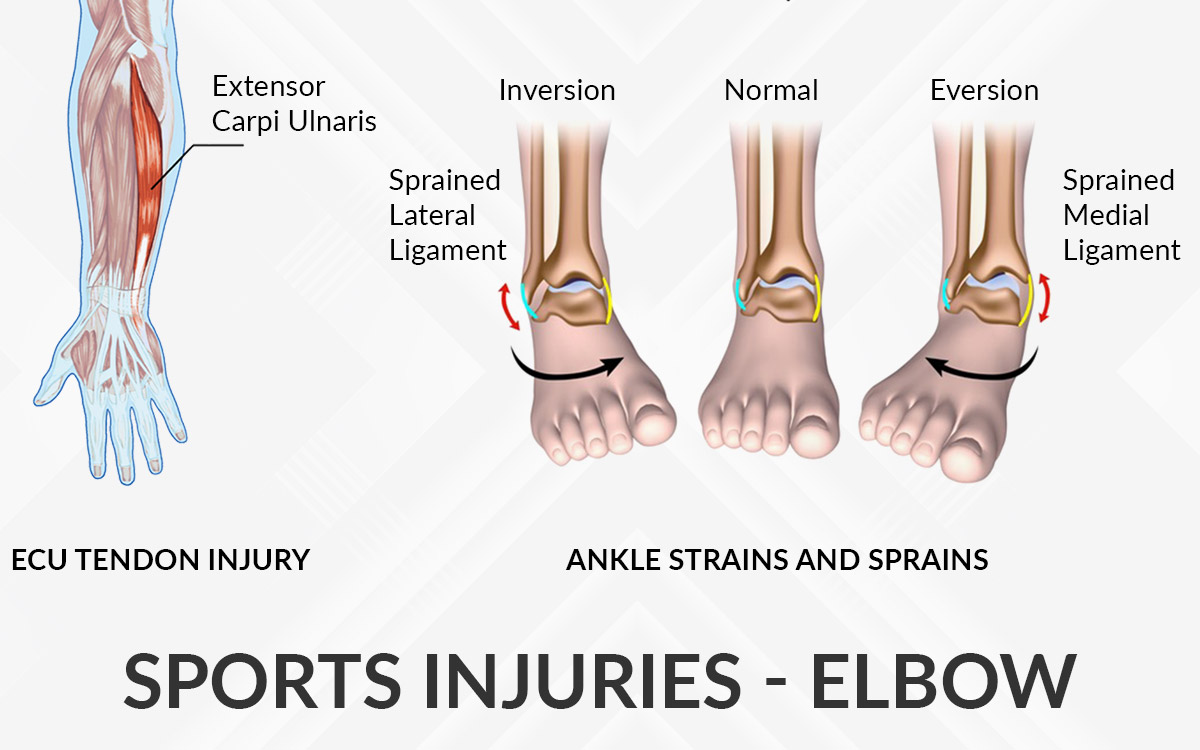
Summary
Sports Injuries associated with the Elbow
- Tennis – Tennis elbow ( lateral epicondylitis )
- Tennis – ECU tendon injury
- Golf – Golfers elbow
- Sprain, Strains and other soft tissue injuries
Tennis – Tennis Elbow (Lateral Epicondylitis)
Tennis elbow is a painful condition which happens when the tendons on the outside of your elbow; usually secondary to repetitive movements gets strained and becomes painful. As the name suggests it can happen in people who play tennis along with plumbers, painters, carpenters and butchers.
You will normally feel pain where the tendons of your forearm muscles attach to a bony bump on the outside of your elbow. Pain can travel into your forearm and wrist.
Main stay of treatment for tennis elbow is muscle stretching and strengthening exercises for which you will be referred to a physiotherapist. Occasionally steroid injections or platelet rich plasma injections are used. Very occasionally keyhole surgery is done to relieve the symptoms.
Tennis – ECU Tendon Injury
ECU (extensor carpi ulnaris) tendon injury commonly happens because of overuse of the wrist and very occasionally secondary to a trauma. Symptoms can range from a mild ECU tendonitis to a frank instability. It can happen whilst playing tennis and even golf. Patients will have pain, swelling over the dorsal ulnar part of the wrist and sometimes tendon can even snap during rotation of the forearm.
If symptoms are severe you will have to see your doctor. He will take a detailed history and order an ultrasound scan or a MRI scan.
Mild cases of ECU Tendinitis can be treated with rest, splinting and non-steroidal anti inflammatories, whereas severe inflammation can necessitate cortisone injection or key hole surgery to the wrist followed by open repair to the tendon and its sheath which anchors it to the ulna head and wrist
Golfers Elbow
Golfers elbow is similar to tennis elbow but in this condition, pain happens on the inside of the elbow. It will happen because of the repetitive strain injury to the tendons of your forearm muscles which attach on a bony bump on the inside of your elbow.
It is usually caused by overusing the muscles in the forearm that allow you to grip, rotate your arm, and flex your wrist. Repetitive flexing, gripping, or swinging can cause pulls or tiny tears in the tendons.
Conservative treatments usually work for golfer’s elbow.
- Rest. Put your golf game or other repetitive activities on hold until the pain is gone.
- Ice the affected area. Apply ice packs to your elbow for 15 to 20 minutes at a time, three to four times a day for several days.
- Use a brace.
- Stretch and strengthen the affected area.
But if you’re still having pain after three to six months, you may need surgery. These procedures can remove damaged parts of a tendon, promote healing, and reduce pain. Full recovery may take three to six months.
Sprains, Strains and Other Soft Tissue Injuries
Elbow joint is surrounded by muscles, tendons and the bones.
A sprain is an injury to the ligaments around a joint. A ligament is a band of tissue that connects bone to bone. The ligaments in your elbow help connect the bones of your upper and lower arm around your elbow joint. When you sprain your elbow, you have pulled or torn one or more of the ligaments in your elbow joint.
Some elbow sprains and strains occur suddenly, such as when you break a fall with an outstretched arm. Symptoms can include pain, tenderness, or swelling around the elbow during movement or at rest. It can become difficult to bend or extend the elbow, or you may experience bruising, redness, or warmth around the elbow.
If your elbow shows any of the following below signs you may have a fracture or another injury that may need medical attention.
- Swelling of your elbow or in the area immediately above or below your elbow.
- Deformity of your elbow, or the areas near your elbow.
- Discoloration, such as bruising or redness of your elbow.
In general, the elbow ligaments when injured will heal without surgery. In fact, persistent elbow instability after an injury is fairly rare. However, elbow stiffness is far more likely to occur. The most significant injury affecting the elbow ligaments occurs in an elbow dislocation.
Self-care at home
- Rest your elbow. Avoid lifting anything with your arm and elbow. …
- Ice your elbow for 15 to 20 minutes at a time, 3 to 4 times a day. Wrap the ice in cloth.
- Compress the area by wrapping it with an elastic bandage or compression wrap.
- Elevate your elbow by raising it above the level of your heart.
You may need to wear a sling, splint, or cast for about 2 to 3 weeks while your elbow heals. Depending on how badly it is sprained, you may need to work with a physical therapist who will show you stretching and strengthening exercises. Most people recover completely from a simple elbow sprain in about 4 weeks.
BMI Chelsfield Park Hospital
Bucks Cross Road Chelsfield ORPINGTON BR6 7RG
01689 877855
BMI The Blackheath Hospital
40-42 Lee Terrace Blackheath LONDON SE3 9UD
020 8318 7722
BMI The Sloane Hospital
125 Albemarle Road BECKENHAM BR3 5HS
020 8466 4000
Princess Royal University Hospital
Farnborough Common ORPINGTON BR6 8ND
01689 863223



